Going solo in Galápagos? Do it!
Looking for a wonderful trip as a single? Then take a look at the Galápagos Islands. We know how you can visit the islands without paying the costly single ...
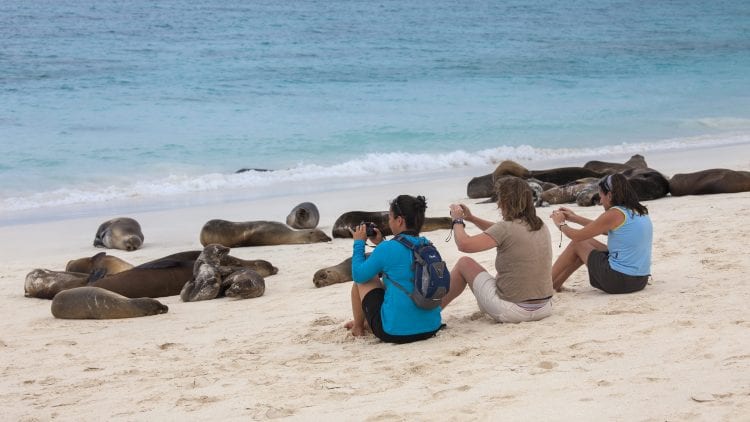
The archipelago is an all-year destination. Although there are differences in the weather, every season is pleasant in its own way. Due to its location at the equator, the climate is mostly dry and warm and is considered “tropical”. Contrary to what you would expect in this climate, however, you will not find exotic palm beaches on Galápagos, but you will find arctic penguins swimming with tropical fish. How is this possible?
The four most important sea currents that converge on the islands are the key factor in determining the weather and animal life in the archipelago. These are the Cromwell undercurrent and the Humboldt and Panama current that merge into the Equatorial stream. Because the islands are at the intersection of these sea currents, there is a huge difference in temperature and humidity. The currents together with the rotation of the earth and the change between summer and winter in the northern and southern hemisphere give the islands a distinct seasonal feeling.
The dry season is from June to November. The strong southeast winds drive the cold Humboldt and Cromwell currents to the islands. The temperatures are falling. The humidity is trapped in clouds. It doesn’t rain, but it is cloudy and foggy, especially in the morning and in the highlands. In the Galápagos this period is known as “garúa” which means “fog / drizzle”. You can expect an average temperature of 15˚C to 25˚C and the water temperature varies between 18˚C and 24˚C.
The wet season takes place from December to May, when the northeast wind drives the mighty hot stream of Panama. During these months you will experience short, heavy monsoon rainfall, often at the end of the day or at night. The extent to which this happens is highly dependent on the power of El Niño. The islands turn lush green due to the rain. In addition to the rain showers, these months also have the most sunny days of the year with clear blue skies. The temperatures are high and can rise above 30˚C, the water temperature is very pleasant from 21˚C to 26˚C.
And what about the Cromwell undercurrent? The Cromwell flows at about 100 meters depth, from west to east along the equator. When this stream reaches the Galápagos from the west, it is pushed up to the surface, bringing even more cool, nutrient-rich water to the marine reserve. The Cromwell stream is (together with the Humboldt) the reason why the waters on the Galápagos are so rich in animal life; here they find sufficient food.
For more detail, below you can read what to expect from month to month.
Marine iguanas on Española change colour to bright green, red and black.

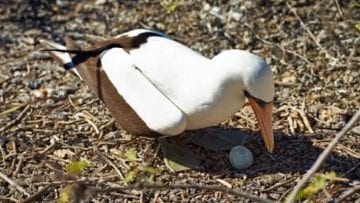
Average maximum temperature: 28˚C
Average minimum temperature: 23˚C
Sea temperature (min-max): 22-26˚C
Average rainfall: 47 mm
Beginning of the warm rainy season, already started in December due to the flow of the warm gulf stream. In the mornings it is sunny and as the temperature rises short rain showers can occur in the afternoon. The “garúa” fog of the previous months has completely disappeared.
The beginning of January is still regarded as the high season on the Galápagos. When the tourists of the Christmas and New Year holidays return home during the month, the low season starts. In January, February and March the water is clearest and you have the best view while snorkeling.
Land birds (such as Darwin Finches, Mocking birds and the Yellow Warbler) start to build their nests. In these months when the rain falls, the islands turn green again and plants begin to bloom – providing enough food to feed the little ones.
The Bahama Pintail Duck builds its nest and starts the breeding season (in January and February).
On Genovesa and Punta Pitt, San Cristóbal: mating season of the Great Frigatebird. A very nice moment to see, because during this season the males inflate their red throat to attract a female. The nest is built together by the male and female; the frigatebird is notorious for stealing nesting material from other birds such as the red footed booby (this period runs from December to May).
On Española Nazca boobies are nesting (from November to February).
All year round only on Seymour Norte: Magnificent Frigatebird build nests and breed. This means that you can experience the beautiful mating ritual of the Frigatebird with the inflated red throat all year round on Seymour Norte.
The mating season of the Galápagos giant tortoise begins (from January to May).
The eggs of the Galápagos giant tortoise hatch. The tortoises mate from January to May. The female then migrates to the lowlands from June to December to lay her eggs there. After 4 to 6 months the eggs hatch exactly at the start of the rainy season when the lowlands turn green and provide sufficient food (the first lay in June has a longer incubation period than the last lay in December). It takes the little ones 30 days to dig themselves out of the nest.
The females of the Green Marine Turtle come to the beach to lay eggs (between December and March).
Galápagos land iguana on Isabela builds its nest and lays eggs (hatch in April).
The adult male marine iguanas on Española change colour to bright green, red and black in preparation for the mating season. They nest in February and March, the eggs hatch in May.
The mating season of the Galápagos sea lion is coming to an end (from May to January). The pups are born after a gestation period of 11 months and then drink for another 11 to 12 months with their mother. Due to the long mating season and this long maternal care, you can see pups on the islands throughout the year.
The Penguins of Bartolomé migrate to the west of the archipelago.

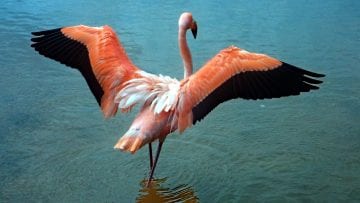
Average maximum temperature: 29˚C
Average minimum temperature: 24˚C
Sea temperature (min-max): 23-29˚C
Average rainfall: 97 mm
The sea temperature is now at its peak especially in the east of the archipelago. There is little wind in this month, at this time, along with the month of March, the sea is the most calm. In February, the number of days with sun rises, but the rainfall also rises, which is reflected in short, heavy showers, often in the afternoon and evening.
February is seen as low season, while the archipelago is very beautiful to visit at this time. In January, February and March the water is clearest and you have the best view while snorkeling. How about a romantic Galápagos Cruise for Valentine’s Day?
One of the most active months for nesting land birds.
The Bahama Pintail Duck builds its nest and starts the breeding season (in January and February).
On Genovesa and Punta Pitt, San Cristóbal: mating season of the Great Frigatebird. A very nice moment to see, because during this season the males inflate their red throat to attract a female. The nest is built together by the male and female; the frigatebird is notorious for stealing nesting material from other birds such as the red footed booby (this period runs from December to May).
The breeding season of the Nazca booby is ending on Española. The practice of “siblicide” (cainism) is remarkable. The female lays two eggs a few days apart. When the first chick comes into the world, it will remove the second egg from the nest, making this chick doomed to die. The Nazca booby will always raise just a single chick.
The Flamingo is starting to build its nest on Floreana.
This is the nesting season of the Galápagos dove.
All year round only on Seymour Norte: Magnificent Frigatebird build nests and breed. This means that you can experience the beautiful mating ritual of the Frigatebird with the inflated red throat all year round on Seymour Norte.
The Penguins of Bartolomé leave the area in search of colder waters in the west of the archipelago.
Mating season of the Galápagos giant tortoise (from January to May).
Eggs of the Galápagos giant tortoise hatch. (from the end of December to April).
The females of the Green Marine Turtle come to the beach to lay eggs (between December and March).
Galapagos land iguana builds its nest and lays eggs (hatch in April).
The marine iguanas on Santa Cruz nest in February and March, the eggs hatch in May.
The islands are beautifully lush and green
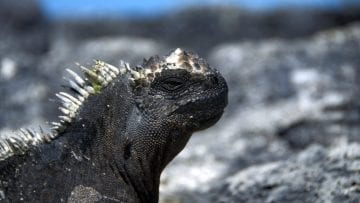
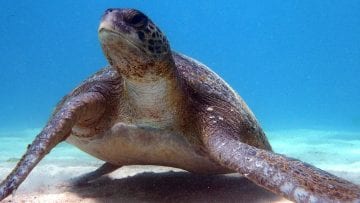
Average maximum temperature: 30˚C
Average minimum temperature: 24˚C
Sea temperature (min-max): 23-30˚C
Average rainfall: 97 mm
March is the month of contradiction. You will find the highest number of days of sunshine, but also the largest amount of precipitation. The rain falls in short tropical showers towards the end of the day. There is little wind in this month, at this time, along with the month of February, the sea is the most calm. However, there are stronger currents along the coast on the north side of the islands that you must take into account when diving and snorkeling. The sea temperature is now at its peak. Also in the west of the archipelago (Isabela and Fernandina where the water is generally cooler) it is now pleasant to snorkel. Experience the miracle of seeing penguins in combination with tropical fish at the same place!
March is seen as low season while it is one of the best months to travel: the number of sun hours is at its peak, the water is wonderfully warm for snorkeling and the sea is calm. The tropical showers are short and intense. A perfect moment to say goodbye to the European winter and start summer early!
Flora: due to the rainfall, the islands are beautifully lush and green.
At the end of the month, the first group of males from the Galápagos Waved Albatross returns to Española, awaiting their females. The albatross is monogamous and they choose their partner for life, even if they are separated after the breeding season, they will return to each other at this island the following season.
On Genovesa and Punta Pitt, San Cristóbal: mating season of the Great Frigatebird. A very nice moment to see, because during this season the males inflate their red throat to attract a female. The nest is built together by the male and female; the frigatebird is notorious for stealing nesting material from other birds such as the red footed booby (this period runs from December to May).
Eggs of the Nazca Booby hatch on Genovesa.
All year round only on Seymour Norte: Magnificent Frigatebird build nests and breed. This means that you can experience the beautiful mating ritual of the Frigatebird with the inflated red throat all year round on Seymour Norte.
Mating season of the Galápagos giant tortoise (from January to May).
Eggs of the Galápagos giant tortoise hatch. (from the end of December to April).
The last females of the Green Marine Turtle come to the beach to lay eggs (between December and March).
Galapagos land iguana builds its nest and lays eggs (hatch in April).
The marine iguanas on Santa Cruz nest in February and March, the eggs hatch in May. This month also on Fernandina the marine iguana will start building its nest.
The Galápagos Waved Albatross returns home to Española after three months at sea.

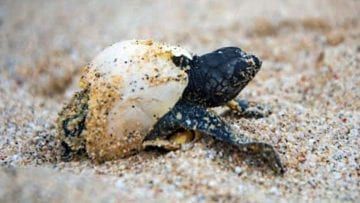

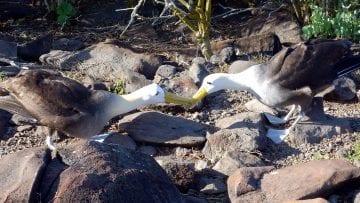
Average maximum temperature: 30˚C
Average minimum temperature: 24˚C
Sea temperature (min-max): 23-29˚C
Average rainfall: 82 mm
The rainy season is declining in April. It is the month with many days of sunshine. The rain falls in short tropical showers towards the end of the day. The temperature of the sea water is now at its peak. Also in the west of the archipelago (Isabela and Fernandina where the water is cooler) it is now pleasant to snorkel. Experience the miracle of seeing penguins in combination with tropical fish at the same place!
The number of tourists is relatively low, with the exception of the holidays around Easter. It is a very nice month to visit the Galápagos. The moments of rain are decreasing, the number of hours of sunshine is at its peak and the islands are lush green. The water is clear and beautiful for snorkeling.
If you are traveling with children, the spring break is a very good choice to go to the Galápagos. Intercontinental airline tickets are often less expensive than in the months of July / August.
On Genovesa and Punta Pitt, San Cristóbal: mating season of the Great Frigatebird. A very nice moment to see, because during this season the males inflate their red throat to attract a female. The nest is built together by the male and female; the frigatebird is notorious for stealing nesting material from other birds such as the red footed booby (this period runs from December to May).
At the end of March the first male Galápagos Waved Albatrosses arrived on Española after being away from home for the last three months. In this month they return en masse and the females join them to see their partner again. The young from 6 years ago now return for the first time to find their partner for life.
The Galápagos storm petrel starts breeding season on Genovesa. The season runs from April to October.
All year round only on Seymour Norte: Magnificent Frigatebird build nests and breed. This means that you can experience the beautiful mating ritual of the Frigatebird with the inflated red throat all year round on Seymour Norte.
Mating season of the Galápagos giant tortoise (from January to May).
The last eggs of the Galápagos giant tortoise hatch. (from the end of December to April).
The first eggs from the Green Marine Turtle hatch, often the little ones come above ground at night.
The eggs of the land iguana on Isabela hatch.
Las Tintoreras is teeming with new-born Marine Iguanas.
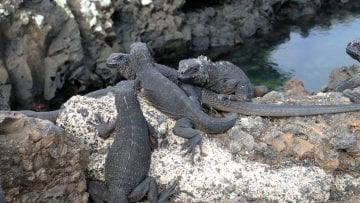
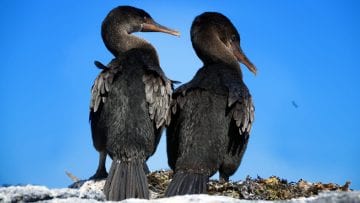
Average maximum temperature: 30˚C
Average minimum temperature: 23˚C
Sea temperature (min-max): 23-27˚C
Average rainfall: 14 mm
The transition month from wet to dry season, when the cold Humboldt current becomes dominant in the waters of the Galápagos. The dry season starts with an average of only 3 to 4 days a month of rain. In addition, May has the highest number of sunny days.
May is a very nice month in Galápagos. The dry season has begun, this month gives you the most days with sun and at the beginning of the month the islands are still nicely green from the last rainy season (towards the end of the month the Palo Santo trees have lost their leaves and only the highlands are still green). The number of tourists is high in this month due to the May holidays. If you want to travel with children in this month (which is advisable compared to July / August because the airline tickets are often more expensive), book far in advance. The ships with the best price / quality ratio are fully booked.
On Genovesa and Punta Pitt, San Cristóbal: mating season of the Great Frigatebird comes to an end. A very nice moment to see, because during this season the males inflate their red throat to attract a female. The nest is built together by the male and female; the frigatebird is notorious for stealing nesting material from other birds such as the red footed booby (this period runs from December to May).
Mating season of the Flightless Cormorant (west of Isabela and Fernandina) begins. The male courtes the female in the water, entangling their necks, after which he leads her to land to build their nest. The male supplies the material, the female builds. Eggs are laid between May and October. The egg hatches after 35 days.
The Galápagos Waved Albatross starts laying eggs on Española.
The breeding season of the Galápagos storm petrel on Genovesa. The season runs from April to October.
The Madeira storm petrel starts nesting.
All year round only on Seymour Norte: Magnificent Frigatebird build nests and breed. This means that you can experience the beautiful mating ritual of the Frigatebird with the inflated red throat all year round on Seymour Norte.
Mating season of the Galápagos giant tortoise comes to an end (from January to May).
The last eggs of the Green Marine Turtle hatch, often the little ones come above ground at night. Especially seen on Bahía Gardner, Punta Cormorant and Puerto Egas.
The eggs of the Marine Iguana hatch after an incubation period of 3 to 4 months. Las Tintoreras in the south of Isabela is teeming with little ones. This is the only place on Galápagos where there are no natural enemies for the iguana.
The Blue Footed Booby performs its “blue-feet-dance” to court the female.
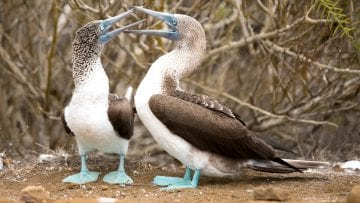
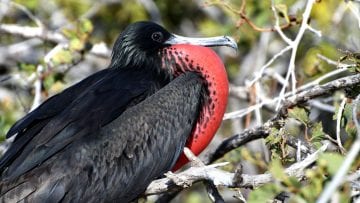
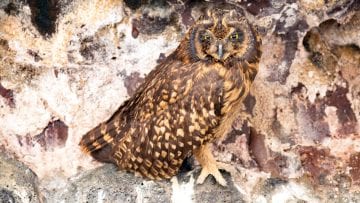
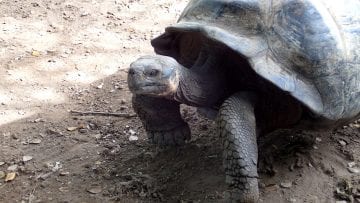
Average maximum temperature: 28˚C
Average minimum temperature: 22˚C
Sea temperature (min-max): 22-25˚C
Average rainfall: 2 mm
The cold wind from the southeast is becoming stronger and the dry season has really begun. The temperature of the water starts to fall and the air temperature also cools down; some nights may even be a bit cool. While the wind picks up, the waves at sea are increasing somewhat as well.
A nice month for a visit to the islands: no rainfall, the temperature is very pleasant and there are still many cloudless days because the “garúa” season has begun but is not yet at its peak. The hustle and bustle of the high season does start, however, because schools are starting to close for school holidays. Advance booking is advised!
The breeding season of the Galápagos storm petrel on Genovesa. The season runs from April to October.
Mating season of the Blue Footed Booby. Mating is preceded by an extensive courtship ritual. The male presents a stick or a stone to the female. He then points his beak, tail and wing tips to the sky, whistles and marches around the female, showing off his blue feet. The more beautiful blue the feet, the more chance it has. If the attraction is mutual, the couple often stays together for life. Particularly on display at Seymour Norte, but can also be seen at Española, Fernandina, Floreana, Isabela, Pinzón, and Santa Cruz. (mating season between June and August).
Mating season of the Flightless Cormorant (west of Isabela and Fernandina) begins. Eggs are laid between May and October. The egg hatches after 35 days.
On Española the eggs of the Waved Albatross hatch (for two months). The male and female alternate on the nest. Strangely enough, the Albatross has the habit of rolling the egg, sometimes over distances of up to 40 meters for a few days. This is a risk, because eggs can break as a result. Some eggs are also abandoned and can then be adopted by couples who have lost their eggs.
On Genovesa the Short Eared Owl starts nesting.
All year round only on Seymour Norte: Magnificent Frigatebird build nests and breed. This means that you can experience the beautiful mating ritual of the Frigatebird with the inflated red throat all year round on Seymour Norte.
The migration of female Galápagos giant tortoises to the lowlands, to lay her eggs, is starting . The tortoises mate from January to May. The female then migrates from June to December to the lowlands to lay her eggs. After 4 to 6 months the eggs hatch exactly at the start of the rainy season when the lowlands turn green and provide sufficient food (the first lay in June has a longer incubation period than the last lay in December). It takes the little ones 30 days to dig out sight of the nest.
June is the month of peak traffic on the islands with animals that migrate, both in the air and in the water. Many migratory birds begin their journey north and make a stopover on the islands. The humpback whale also arrives with the Humboldt current from the south via Peru and the coast of Ecuador to the Galápagos.
Whale sharks can be spotted in the north west of the archipelago.
High Season! Book your visit to the Galápagos Islands far in advance.
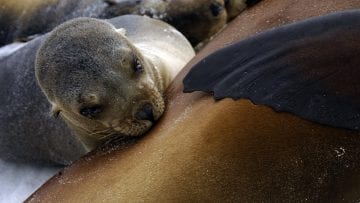
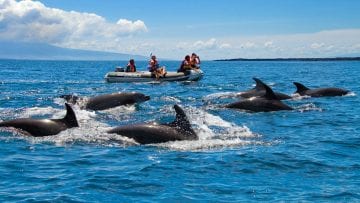
Average maximum temperature: 26˚C
Average minimum temperature: 21˚C
Sea temperature (min-max): 21-24˚C
Average rainfall: 2 mm
The cold Humboldt current from Antarctica is making a strong entrance and with the change of currents, the waves are getting bigger. The islands are windy and you can expect a somewhat choppy sea. The “garúa” season has now really begun: most days are cloudy and there is fog, particularly in the highlands. It hardly rains. In the evening it is cool and you will occasionally need a light sweater or jacket.
Due to the school holidays, the months of July and August are really high season. If you want to go on a cruise expedition, you must book well in advance to have sufficient choice. If you are looking for a last-minute opportunity, Island Hopping (stay in hotels and daily excursions to the visitor sites) might be a good alternative. Also if you are prone to seasickness, Island Hopping may be a better choice during this period; the sea has the strongest currents with many waves in July and August, making any boat tour a bit restless.
The breeding season of the Galápagos storm petrel on Genovesa. The season runs from April to October.
Mating season of the Blue-Footed Booby. Observe this cheerful ritual at Seymour Norte, but also present at Española, Fernandina, Floreana, Isabela, Pinzón, and Santa Cruz. (mating season between June and August). Especially on Seymour Norte and Española all phases come together this month: the mating ritual, eggs, chicks and young ones that try to spread their wings for the first time.
Mating season of the Flightless Cormorant (west of Isabela and Fernandina) begins. Eggs are laid between May and October. The egg hatches after 35 days.
On Española the last eggs of the Waved Albatross hatch (for two months). The male and female alternate on the nest. Strangely enough, the Albatross has the habit of rolling the egg, sometimes over distances of up to 40 meters for a few days. This is a risk, because eggs can break as a result. Some eggs are also abandoned and can then be adopted by couples who have lost their eggs.
All year round only on Seymour Norte: Magnificent Frigatebird build nests and breed. This means that you can experience the beautiful mating ritual of the Frigatebird with the inflated red throat all year round on Seymour Norte.
The migration of female Galápagos giant tortoises to the lowlands, to lay her eggs (June to December).
The mating season of the Galápagos sea lion (from July to December). The pups are born after a gestation period of 11 months and then drink for another 11 to 12 months with their mother. Due to the long mating season and this long maternal care, you can see pup on the islands throughout the year. Most young are born in the months of August, September and early October.
The Humboldt current brings many micronutrients to the waters and marine life becomes more active. There is more chance to spot dolphins and whales, especially between Isabela and Fernandina and at Santiago and Baltra.
A perfect month for divers

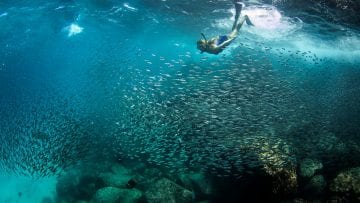
Average maximum temperature: 26˚C
Average minimum temperature: 20˚C
Sea temperature (min-max): 20-23˚C
Average rainfall: 1 mm
The cold season continues in August. There are few really sunny days. At this time there is a lot of “garúa” (drizzle, low clouds and fog), especially in the mornings. On the other hand, it is not raining either during these months, which makes it a good time to travel. Certainly if you do not feel comfortable with bright sun and warm temperatures of 25 to 30 degrees. In your suitcase you pack a sweater and wind jacket.
Due to the school holidays, the months of July and August are really high season. If you want to go on a cruise expedition, you must book well in advance to have sufficient choice. If you are looking for a last-minute opportunity, Island Hopping (stay in hotels and daily excursions to the visitor sites) might be a good alternative. Also if you are prone to seasickness, Island Hopping may be a better choice during this period; the sea has the strongest currents with many waves in July and August, making any boat tour a bit restless.
De maanden augustus, september en oktober zijn het ideale seizoen voor ervaren duikers. De stroming is weliswaar sterker, maar door de koude Humboldt zijn er veel voedingsstoffen en is het leven onderwater zeer actief.
Op Genovesa begint de Nazcagent met het bouwen van nesten (van augustus tot november)
Het broedseizoen van de Galápagos stormvogel op Genovesa (van april tot oktober).
Het einde van het paringsseizoen van de blauwvoetgent. Observeer dit vrolijke ritueel op Seymour Norte, maar ook aanwezig op Española, Fernandina, Floreana, Isabela, Pinzón, en Santa Cruz. (paringsseizoen tussen juni en augustus). Vooral op Seymour Norte en Española komen deze maand alle fases samen: het paringsritueel, eieren, kuikens en jongen die hun eerste vleugels proberen uit te slaan.
De Galápagosalbatros brengt haar kuikens groot op Española. Enkele weken na het uitkomen worden de kuikens achtergelaten in “kinderdagverblijven”, zodat beide ouders kunnen gaan eten en de kuikens bij terugkeer kunnen voeden. Ongeveer vijf en een halve maand na het uitkomen zullen de kuikens voldoende ontwikkeld zijn om te kunnen vliegen en eenmaal volledig uitgevlogen, zullen de vogels tot zes jaar op zee verblijven voordat ze naar Española terugkeren om een partner voor het leven te vinden.
De paringstijd van de Galápagosbuizerd op Española en Santiago.
Het paringsseizoen van de Galápagosaalscholver (westen van Isabela en Fernandina). Eieren worden gelegd tussen mei en oktober.
Hele jaar alleen op Seymour Norte: Amerikaanse Fregatvogels (Magnificent Frigatebird) bouwen nesten en broeden. Dit betekent dat u alleen op Seymour Norte het gehele jaar het prachtige paringsritueel van de fregatvogel met de opgeblazen rode keelzak kunt aanschouwen.
De migratie van vrouwtjes Galapagosreuzenschildpadden naar de laaglanden om daar haar eieren te leggen (juni tot december). De eerste schildpadden keren nu ook weer terug in de hooglanden.
Het paringsseizoen van de Galápagos zeeleeuw (van juli tot december). De pups worden na een zwangerschapsperiode van 11 maanden geboren en drinken vervolgens nog 11 tot 12 maanden bij hun moeder. Vanwege de lange paringstijd en deze lange moederlijke zorg kunt u het gehele jaar door pups op de eilanden aanschouwen. In de maanden augustus, september en begin oktober worden de meeste jongen geboren.
De Humboldtcurrent brengt veel micronutriënten naar de wateren en het zeeleven wordt actiever. Er is meer kans om dolfijnen en walvissen te spotten, met name tussen Isabela en Fernandina en bij Santiago en Baltra.
Sea lion colonies are restless. Their mating season is in full swing.
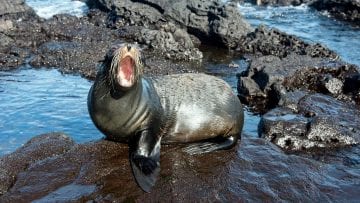
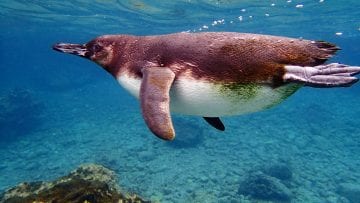

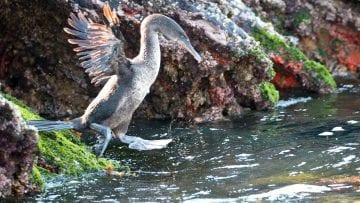
Average maximum temperature: 26˚C
Average minimum temperature: 20˚C
Sea temperature (min-max): 19-23˚C
Average rainfall: 1 mm
September is the peak of the cold season. You cannot expect really sunny days. At this time there is a lot of “garúa” (drizzle, low clouds and fog). On the other hand, The is no rain in these months either. The afternoon temperature can drop to 19 degrees, at night to 18 degrees. In your suitcase you pack a sweater and wind jacket.
After the high season of August it is nice and quiet again in September. It is not raining, there is no bright sun and the temperature is pleasantly cool; perfect weather for hiking. During snorkeling you definitely need a wet suit against the cold. The months of August, September and October are the ideal season for experienced divers. The current is indeed stronger, but due to the Humboldt there are many nutrients and marine life is very active.
Nazca Boobies nesting on Genovesa (from August to November).
The breeding season of the Galápagos storm petrel on Genovesa. The season runs from April to October.
Togther with the cold current, the Galápagos penguin has also returned to Bartolomé and is very active there.
Mating season of the Flightless Cormorant (west of Isabela and Fernandina). Eggs are laid between May and October. The egg hatches after 35 days.
The Galápagos Waved Albatros raises her chicks on Española. A few weeks after hatching, the chicks are left in “daycare centers”, so that both parents can eat and feed the chicks on their return. About five and a half months after hatching, the chicks will be sufficiently developed to be able to fly and once fully fledged, the birds will stay at sea for up to six years before returning to Española to find a partner for life.
All seabirds are very active around the nest. The eggs have hatched and with the cold current there are a lot of nutrients available that must be brought to the nest. This also applies to the Blue-Footed Booby. The bird fishes during the day and rests at night. It is impressive to see how they, sometimes from a height of 20 meters with speeds of up to 95 km/h, dive into the water like little bombs to catch their prey.
All year round only on Seymour Norte: Magnificent Frigatebird build nests and breed. This means that you can experience the beautiful mating ritual of the Frigatebird with the inflated red throat all year round on Seymour Norte.
The migration of female Galápagos giant tortoises to the lowlands, to lay her eggs (Juni to December). The first tortoises now also start returning back to the highlands.
The sea lion colonies are restless. The mating season is in full swing. Male sea lions defend their coast and fight for their harem to establish their territory. In addition, there are many pups that were born the previous month. It is especially important to allow the male his space during this time.
The Galápagos fur seal starts mating season, to be found on Genovesa and northwestern Santiago. Like the Galápagos sea lion, the male defends his territory which can lead to intense fighting.
September (and October) is one of the best months to spot dolphins and whales.
October is one of the best months to spot dolphins and whales.
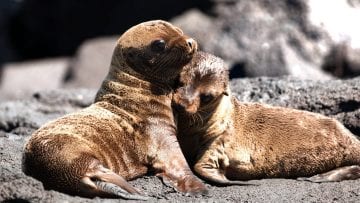
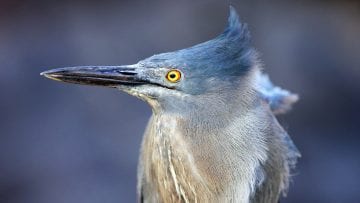
Average maximum temperature: 27˚C
Average minimum temperature: 20˚C
Sea temperature (min-max): 19-24˚C
Average rainfall: 0 mm
In October the “garúa” season is slowly coming to an end. The temperatures are rising slightly, but you definitely need a wetsuit for snorkeling. The views become more beautiful, in the morning, fog often hangs low across the ocean and highlands and the tops of the volcanoes are visible, making for amazing landscape photography. Because the sun does not shine brightly during this period, you can take beautiful photos overall! In your suitcase you bring a sweater and wind jacket for these months.
A wonderful month to postpone the confrontation with the European winter. If you are traveling with children, the autumn holiday is a very good choice to go to the Galápagos. Intercontinental airline tickets are cheaper than in the months of July / August. In addition, this is a low season on the islands. There are often good promotions available for cruise expeditions, but not all ships are available. Ships are required to perform maintenance every 2 years. The month of October is almost always chosen as the moment to go into a dry dock. The months of August, September and October are the ideal season for experienced divers. The current is stronger, but due to the cold Humboldt there are many nutrients and marine life is very active.
Nazca Boobies nesting on Genovesa (from August to November).
End of the breeding season of the Galápagos storm petrel on Genovesa. The season runs from April to October.
Breeding season of the Flightless Cormorant (west of Isabela and Fernandina) comes to an end. Eggs are laid between May and October. The egg hatches after 35 days.
The Galápagos Lava Heron starts building its nest.
The nesting season of the Blue Footed Booby, on Seymour Norte and Española, is coming to an end. The chicks are still small. In contrast to the Nazca Booby, the Blue Footed Booby mostly raises 2 chicks. However, only if there is sufficient food. If there is not enough food, the first-born, and strongest, chick will demand the most food, causing the second chick to die. Approxinately 108 days after the hatching of the egg the young will fledge.
The Galápagos Waved Albatros raises her chicks on Española. A few weeks after hatching, the chicks are left in “daycare centers”, so that both parents can eat and feed the chicks on their return. About five and a half months after hatching, the chicks will be sufficiently developed to be able to fly and once fully fledged, the birds will stay at sea for up to six years before returning to Española to find a partner for life.
All year round only on Seymour Norte: Magnificent Frigatebird build nests and breed. This means that you can experience the beautiful mating ritual of the Frigatebird with the inflated red throat all year round on Seymour Norte.
The migration of female Galápagos giant tortoises to the lowlands, to lay her eggs (Juni to December). Tortoises now also start returning back to the highlands.
The mating season of the Galápagos sea lion (from July to December). The pups are born after a gestation period of 11 months and then drink for another 11 to 12 months with their mother. Due to the long mating season and this long maternal care, you can see pup on the islands throughout the year. Most young are born in the months of August, September and early October.
Galápagos fur seal mating season, to be found on Genovesa and northwestern Santiago. Like the Galápagos sea lion, the male defends his territory which can lead to intense fighting.
October (and September) is one of the best months to spot dolphins and whales.
Mating season of the Green Marine Turtle. They are extra active in and around the water during this time.
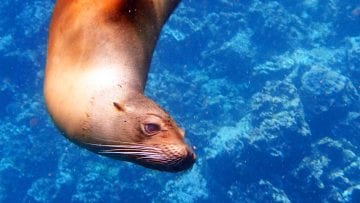
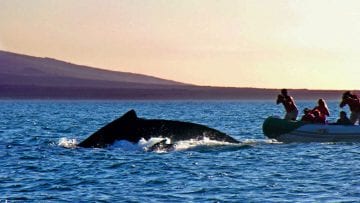
Average maximum temperature: 27˚C
Average minimum temperature: 21˚C
Sea temperature (min-max): 20-24˚C
Average rainfall: 1 mm
The wind has decreased so that the sea is calm again, the fog has disappeared, it is not raining and it is not as warm as at the beginning of the year. The water is still cold, so you need a wetsuit while snorkeling and in the evening it cools down, you will need a sweater.
November is a wonderful month to visit the Galápagos. Although this is not by definition a high season, ships are quickly full in the last week of November and first week of December. The last Thursday of November is Thanksgiving in the United States and with the popularity of the islands in the USA this has a major influence on the occupancy rate.
Flora: Plaza Sur is now very colourful. On this island you will find the beautiful Sesuvium vegetation, which turns bright red, orange and purple during the dry season.
The breeding season of the Nazca booby is ending on Genovesa. The practice of “siblicide” (cainism) is remarkable. The female lays two eggs a few days apart. When the first chick comes into the world, it will remove the second egg from the nest, making this chick doomed to die. The Nazca booby will always raise just a single chick.
Where the breeding season for the Nazca Booby comes to an end on the island of Genovesa, it is now starting on Española (from November to February)
The Galápagos Waved Albatros raises her chicks on Española. A few weeks after hatching, the chicks are left in “daycare centers”, so that both parents can eat and feed the chicks on their return. The chicks are now almost fully grown.
The Galápagos Brown Noddy starts its breeding season.
The Madeira Storm Petrel starts its second nesting period.
All year round only on Seymour Norte: Magnificent Frigatebird build nests and breed. This means that you can experience the beautiful mating ritual of the Frigatebird with the inflated red throat all year round on Seymour Norte.
The last migration of female Galápagos giant tortoises to the lowlands, to lay her eggs (Juni to December). Tortoises also return back to the highlands.
November is the mating season of the Green Marine Turtle. They are extra active in and around the water during this time.
The mating season of the Galápagos sea lion (from July to December). The pups are born after a gestation period of 11 months and then drink for another 11 to 12 months with their mother. Due to the long mating season and this long maternal care, you can see pup on the islands throughout the year. Most young are born in the months of August, September and early October.
December is a good month to spot dolphins and whales, especially in the northwest of the islands. Sperm whales, humpback whales, orcas and the serene blue whale are present.
Some types of jellyfish are frequently seen during this time. For example, the Portuguese warship is present around Islote Gardner (Española) and Tortuga (south of Isabela) or they end up on the fine white coral beach of Punta Cormorant (Floreana)
The first young Galápagos Waved Albatrosses start to fly on Española.
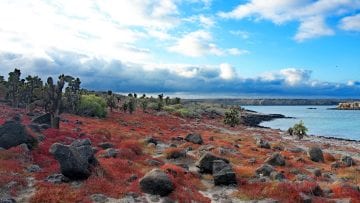
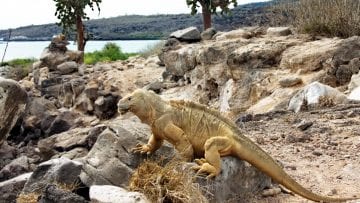
Average maximum temperature: 27˚C
Average minimum temperature: 22˚C
Sea temperature (min-max): 21-25˚C
Average rainfall: 14 mm
The relatively warm sea current from the Gulf of Panama starts to enter the Archipelago. Depending on the strength of El Niño, the warm rainy season starts to a greater or lesser extent in this month. Because the water temperature rises, the temperature on land also starts to slowly increase. Due to the influence of El Niño the weather is a bit unpredictable. With a powerful El Niño it will rain in December, with a weaker influence the first rain will fall in January.
December is high season. With Christmas and New Year holidays, many families are traveling to celebrate the Season in a very beautiful way. A toast to the New Year in this unique environment is very special!
Flora: Plaza Sur is now very colourful. On this island you will find the beautiful Sesuvium vegetation, which turns bright red, orange and purple during the dry season.
Breeding season of Nazca Boobies on Española (from November to February)
On Genovesa and Punta Pitt, San Cristóbal: mating season of the Great Frigatebird starts. A very nice moment to see, because during this season the males inflate their red throat to attract a female. The nest is built together by the male and female; the frigatebird is notorious for stealing nesting material from other birds such as the red footed booby (this period runs from December to May).
The first young Galápagos Waved Albatrosses are starting to fly on Española. In January they are ready to leave the islands. The young will then stay at sea for up to six years before returning to Española to find a partner for life and start breeding.
All year round only on Seymour Norte: Magnificent Frigatebird build nests and breed. This means that you can experience the beautiful mating ritual of the Frigatebird with the inflated red throat all year round on Seymour Norte.
Mating season of the land iguana starts.
The first females of the Green Marine Turtle come to the beach to lay eggs (between December and March).
The first eggs of the Galápagos giant tortoises hatch in the lowlands. The incubation time was 110-175 days. The female has been on her way back to the highlands for some time now and will not see her offspring appear above ground. The gender of the tortoise is determined by the temperature of the egg. The upper, warmer eggs will be females; the lower, cooler egg males; “Hot chicks and cool dudes”.
The mating season of the Galápagos sea lion (from July to December). The pups are born after a gestation period of 11 months and then drink for another 11 to 12 months with their mother. Due to the long mating season and this long maternal care, you can see pup on the islands throughout the year. Most young are born in the months of August, September and early October.